
Day 1
Arrive KashgarArranging your international flight to get to Kashgar, and we will catch you from the airport, or we can meet you at the border (Torgurt or Irkestam pass). In either case, we will transfer you to the hotel and check you in. You will have the rest of the day free to do some exploration at your leisure.
Day 2
Kashgar-
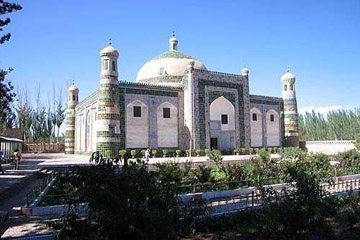
- Apak Hoja Tomb
Today we will take Kashgar city Tour, visiting Id Kah Mosque, Abakh Khoja Tomb and Old Town.
Id Kah Mosque: This is the largest mosque in China, and the most famous mosque in Xinjiang. The construction of the mosque started in the middle of the 15th century, and the mosque has gradually developed to its present size. The buildings of Id Kah Mosque look magnificent and solemn, and display the artistic styles of Islamic mosque architecture. The Mosque has an area of about 16,800 square meters, consisting of the Pray Hall, the Koran teaching Hall, the Corridor, the Arches and other buildings attaching to it. The Pray Hall of the mosque, which can hold 4,000 prayers, is supported by 140 carved wooden pillars.
Apakh Hoja Tomb: This Mazar is the holiest place in Xinjiang for the Muslims, and an architectural treasure. Built in 1640, it is reminiscent of Central Asian artistic style of Samarkand or Isfahan. This site is also known as Xiang Fei (Fragrant Concubine) Tomb in memory of Abakh Khoja's granddaughter, Iparhan, who was the Fragrant Concubine of Emperor Qianlong of Qing Dynasty. A handsome blue-and-white tiled gate leads into the compound, which includes a small religious school and the Abakh Khoja family tomb. The latter is domed and faced with muti-color tiles. It is the most complete Islamic tomb dating from the beginning of the Qing Dynasty.
Old Town: Kashgar is an ancient city, by walking the streets along its Old Town, one gets the sense of what this legendary Central Asian hub was like in the days when the Silk Road was at its zenith. 500-year old remnants of the city wall, narrow lanes and colorful multi-ethnic crowds combined to make Kashgar’s historic district a highlight of any visit to the city. Visit the small alleys to look at the characteristic Uygur residences. You will experience and enjoy the culture and history that has been retained in the small alleys and deep courtyards. In the alleys on platforms beside the residence you could marvel at the even more ancient primitive workshops for hand-made earthenware. Some 17 or 18 antique workshops have been restored.
Day 3
Kashgar-
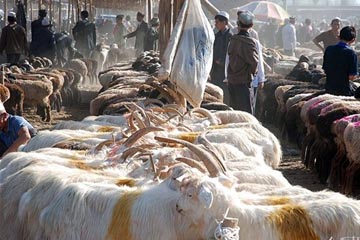
- Sunday bazaar
In the early morning we will visit the Sunday Bazaar, then drive to Karakul Lake.
Sunday Bazaar: This is called “Sunday” bazaar but it is open daily, even though it is busiest on Sundays. Streets near this big market are jammed with farmers and buyers arriving by donkey cart, truck, bicycle, horseback, ute, motor-bike, or on foot, with their animals. It is loud, lively and cheerful when they arrive, eat breakfast, set up their animals and check out the action. Cattle, sheep (they definitely look different), goats, donkeys, horses have their own sections. Sellers show off their animals as “good eaters” (most go as livestock, not meat). The entire experience is fascinating and fun.
Karakul Lake: At an altitude of 3600m, this is the highest lake of the Pamir plateau, near the junction of the Pamir, Tianshan (Heavenly Mountain), and Kunlun Mountain ranges. Surrounded by mountains which remain snow-covered throughout the year, the three highest peaks visible from the lake are the Muztag Ata (7546m), Konur Tagh (7649m) and Kongur Tiube (7530m). The lake is popular among travelers for its beautiful scenery and the clarity of its reflection in the water, whose color ranges from a dark green to azure and light blue. There are two Kirgiz settlements along the shore of Karakul Lake, a number of yurts about 1 km east of the bus drop-off point and a village with stone houses located on the western shores.
Day 4
KashgarAfter Breakfast we will check out of the hotel and do some shopping for the train trip. You will take the train to Kuqa. Our guide will meet you at the station, transfer you to the hotel and check you in. Kucha was an ancient Buddhist kingdom located on the branch of the Silk Road that ran along the northern edge of the Taklamakan Desert in the Tarim Basin and south of the Muzat River.
Day 5
Kuqa-
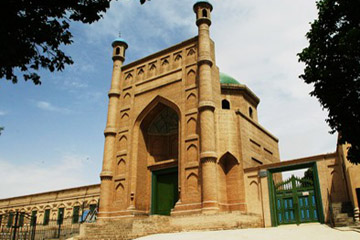
- Kucha Mosque
Today we will visit Tianshan Great Canyon, Kizil Grottoes,Kuqa Mosque.
Tianshan Great Canyon: This is known as the most stunning canyon in China. Five thousand meters in total length, and two hundred meters in average depth, the Great Canyon was once the ancient river course for Kuqa River. We will take one and half hour walk in the Grand Canyon to experience gorgeous scenery, and then enjoy a picnic lunch at a scenic spot before returning on the same route.
Kuqa Mosque: It is located in the north of the old city Kuqa and covers an area of 1165 square meters with a capacity of 3000 people, it is the second largest mosque in Xinjiang. The mosque consists of a main worshiping hall, a small worshiping hall, a minaret, a qubbah, a religious court and hostels, etc. The mosque is a representative of Uygur architectural art of Qing Dynasty.
Kizil Grottoes: Kizil Grottoes (Kizil being spelled variously as Qizil or Qyzyl) are a set of Buddhist rock-cut caves located near Kizil Township in Baicheng County, Xinjiang. The site is located on the northern bank of Muzat River 75 km by road west of Kuqa. This area was once a commercial hub of the Silk Road. The caves are said to be the earliest major Buddhist cave complex in China, with development occurring between the 3rd and 8th centuries. The contents of the cave paintings are very rich, including jataka stories, Buddha’s life story and the stories about karma. Kizil Caves complex is the largest of the ancient Buddhist cave sites that are associated with the ancient Tocharian kingdom of Kucha, as well as the largest in Xinjiang.
Day 6
Kuqa-

- Diversifolious poplar
We will visit Subashi Ruins, Taklamakan Desert, and Tarim River. Then we will take the train to Turpan
Subashi Ruins: Located 23 kilometers northwest of Kuqa County, Xinjiang Province are the ruins of the Subashi Temple. The Ruins are divided by Kuqa River into eastern and western areas. These large area ruins reflect the temple's past brilliance. Subashi Temple was a Buddhism temple, which was built in the first century and reached its peak during the sixth to the eighth centuries in Sui and Tang dynasties. During Tang Dynasty (618 - 907), the hierarch Xuanzang was attracted by the splendor of the temple and the popularity of Buddhism in this area, and stayed here for more than 2 months on his way to India to get Buddhist sutra.
Taklamakan Desert: Taklamakan Desert is the biggest moving desert in the world and most of the people believe that it has buried most of good civilizations of central Asia. It occupies a land of more than 345,000 square km. Taklamakan in local Uyghur language means “Tha desert which buried some places under”. After some western explorers explored this desert in the early part of 20th century, they have given the name another meaning, which is “One goes, but never comes back”.
Diversifolius Poplars Park: The park is located in the north of Taklimakan Desert, and the middle portion of Tarim River. One can see Tarim River, poplar trees, the desert and the oil industry complexes. It is a good resort for sightseeing, entertainment, adventure, scientific expedition and vacation.
Day 7
Turpan-
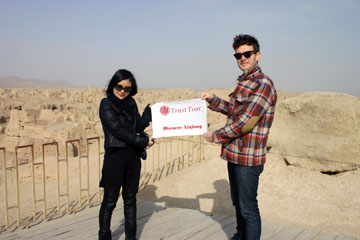
- Jiaohe Ruins
We will catch you from the train station, and we will visit the Jiaohe Ruined city, Karez Irrigation system, Sugong Minerat. We will also visit a local Uyger family in the Vineyard.
Jiaohe Ancient City Ruins: The city's name means 'River City'. It was founded during the first century BC and abandoned during the 15th century. It is located atop a steep cliff on a leaf-shaped plateau between two deep river valleys in the Yarnaz valley 10 km to the west of Turpan City. It runs northwest to southeast, 1760 meters long and 300 meters across at the widest part. The ruins include city gates, streets and lanes, government office, temples, domestic houses, cave houses, wells, and an underground temple. It is part of the UNESCO World Heritage Silk Road Sites.
Karez Irrigation System: The ancient Karez Irrigation System, which is still used today, is a unique irrigation system in Turpan. It takes advantage of the slopes, draws the underground water to flow by itself to irrigate farmland. It consists of four parts: vertical wells, underground channels, ground canals, and small reservoirs
Sugong Minaret: Located in Mura Village 2km to the east of the city of Turpan, the minaret tower was built in the 41st year of the long reign of Qianlong Emperor during the Qing Dynasty. It is the embodiment of the ancient architectural arts of the Uighur people. The body of the tower is cylindroid in shape, built with bricks arranged in various symmetrical patterns on the outer wall. The tower has 14 windows and a spiral staircase inside going to the top.
Local Uyghur Family with Vineyard: Turpan is a kingdom of Grapes, all the local Uyghur families plant grapes at the back of their house. Local Uyghur family visiting is a special experience for you to know their lifestyle in the “fireland”.
Day 8
Turpan-

- The Flaming Mountain:
After breakfast we will visit Tuyoq Valley. Astana Tombs, The Flaming Mountain, and after dinner we will take the soft sleeper train to Dunhuang.
Tuyoq Valley: This is a 12 km long primitive Uighur agricultural valley about 70 km from Turpan, with vineyards and fields in the northern and southern valleys and a narrow ravine that connects them. It is a Muslim religious pilgrimage site. The southern mouth of the valley has big Uighur mosques older than Sugong Minaret and a cave thought by many to be described in the Koran. About a kilometer from the cave shrine is a group of grottoes that have some Buddhist and Nestorian artwork. These grottoes are said to date from the West Jin Dynasty (265AD-316AD), and are considered to be the earliest in Turpan. Most of the murals are damaged. Fortunately, 10 of the grottoes still have some of the preserved murals. These precious murals are very unique in style.
Astana Tombs: This is the graveyard of the residents who lived in the Gaochang City in the Jin-Tang period. Between 1959 and 1975, a great number of cultural relics had been unearthed, including Chinese documents, textiles, epitaphs, coins, clay sculptures, pottery, wooden wares, silk-paintings, crops and foods, etc. The site is known as the Underground Museum.
The Flaming Mountain: The Flaming Mountain is famously described in the classic Chinese mythological novel “Journey to the West”. It runs west from Shanshan County, is 98 km in length and 9 km across, with a relative height of 500 meters and the highest peak at 832 meters. The mountain is a branch range of the Bogda Mountain, formed in the orogenic movements of the Himalayas. This is the hottest place in China. The highest air temperature in summer is 47.8 degrees Centigrade, and the ground is over 70 degrees Centigrade in summer. Many years of volcanic activity have formed the unique crisscrossing gullies and ravines. During mid-afternoon the heat becomes intense as the sun's rays are reflected off the red rocks, as though the hillsides are engulfed by tongues of fire, hence the name.
Day 9
Dunhuang-

- Mogao Caves
Our tour guide will fetch you from the train station and check you into the hotel. After breakfast we will visit Mogao Grottoes. In the afternoon we will visit the Echoing-Sand Mountain and the Crescent Lake, where you can experience camel riding like the traders in a Silk Road caravan.
Mogao Grottoes: Mogao Grottoes is a shrine of Buddhist art treasures, is 25 km from downtown Dunhuang on the eastern slope of Mingsha Shan (Echoing Sand Mountain). A network of plank-reinforced roads plying north to south 1600 meters long lead to the cave openings, which are stacked five stories high, some reaching up to 50 meters. Incidentally, Mogao means high up in the desert. According to Tang Dynasty records, a monk had witnessed onsite a vision of thousand Buddhas under showers of golden rays. Thus inspired, he started the caves construction work that spanned a millennium, from the 4th to the 14th centuries. What remains today is truly awe inspiring, and is likely the world’s richest treasure house of Buddhist sutras, murals and sculptures. Please note that cameras are not allowed inside the grottoes.
Echoing-Sand Mountain and Crescent Lake: Together with the Crescent Spring and Mogao Caves, the Echoing-Sand Mountain is the most popular tourist site in Dunhuang. Echoing-Sand Mountain, known as Mingsha Mountain to the Chinese, is 5 km to the south of Dunhuang and is famous for the constant sound of the moving sand. Legend has it that many years ago a horrific battle was fought here, and the sounds we hear today were the haunting cries of soldiers buried in the sand dunes. Situated within the Echoing-Sand Mountain Park, the Crescent Moon Lake is literally an oasis in the desert. The lake’s name derives from the crescent moon shape taken by the pool of spring water between two large sand dunes. Although the surrounding area is very dry, the pool surprisingly doesn’t dry up as one might expect.
Day 10
Dunhuang-

- The Painting in Weijin Tomb
After breakfast we will drive to Jiayuguan, visiting Yulin Grottoes on the way. We will visit the Weijin Tombs upon arrival in Jiayuguan.
Yulin Grottoes: The Yulin Grottoes lie 70 km to the south of Anxi County, Gansu Province. The Grottoes are chiseled into the cliffs on both the east and west sides of the Yulin River. The east cliff has 30 grottoes and the west has 11, with a distance of more than 100 meters between them. It used to be called Ten-Thousand Buddha Gorge. The grottoes began to be chiseled and sculpted during the Northern Wei Dynasty (386-534), and was enlarged in the later dynasties, such as Tang (618-907), Five Dynasties (907-960), Song (960-1279), the Western Xia (1038-1227), Yuan (1271-1368) and so on. More than 1,000 square meters of frescoes, and more than 100 colored sculptures are still extant there. The name Yulin (elm forest) came from the elms in the valley, and as you travel along the valley road you can easily imagine how it must have been to be a poet or brave solder in the distant past.
Weijin Tomb: About 15 kilometers northeast of Jiayuguan, there are over 1,400 tombs which were built during the Wei and Jin dynasties (between the 3rd and 5th century). They feature brick wall paintings showing various social activities of the times.
Day 11
Jiayuguan-

- The Jiayuguan Pass
Today we will visit Jiayuguan Pass, The Great Wall on the Cliff, and the Great Walls Museum. After dinner take the soft sleeper train to Xi’an
Jiayuguan Pass: Jiayuguan Pass stands in the southwest part of Jiayuguan City, about 6 km away from downtown. Ming Dynasty fort here guards the strategic pass, at the western end of the Great Wall – this was the last section built by the Ming Dynasty. Construction of the fort was started in 1372 in Ming Dynasty, and subsequently enlarged and strengthened, and was known as 'the strongest pass under heaven'. It is located in the Jiayu Highland, hence its name Jiayuguan. It is situated between the Wenshu and Heishan Mountains at the foot of Jiayuguan Hill of the Qilian Mountain range.
The Great Wall on the Cliff: The Suspended Wall is a part of the Great Wall of China. The wall here was built on the ridge with a gradient of 45 degrees. It is high in the air and it looks as if it fell down from the top of the hill. So people refer to this section of the Great Wall as the "Suspended Wall". The Suspended Wall, the extension of the walls at the Jiayuguan Pass towards the north, was an integral part of the ancient defense system at Jiayuguan Pass.
Great Wall Museum: The Great Wall museum opened to visitors in October 1989, and it is the first museum to exhibit the Great Wall culture in a comprehensive and systematic way. The Museum covers an area of 12,312 square meters with an exhibition area of about 1,766 square meters. Its main building takes a shape of a typical signal fire tower on the Great Wall.
Day 12
Lanzhou-

- Labrang Monastery
Our tour guide will meet you at the train station. We will take a cruise from Liujiaxia Gorge to Binglingsi (speed boat). We will visit the Binglingsi Thousand Buddha Caves, and after lunch we will drive to Xiahe to visit Labrang Monastery and Songke Grassland to see the mysterious Tibetan culture.
Bingling Thousand Buddha Caves: Bingling Thousand Buddha Caves are on the cliff of Xiaojishi Hill. Located on a branch of Gansu part of the Silk Road, the Bingling Caves were started by Buddhist monks from as early as the West Jin Dynasty (265AD -316AD) although the official carving began in 420AD. Today there are 183 caves existing with 694 stone statues, 82 earth statues and murals of 900 square meters (9,688 square feet). Another pleasant surprise on your way to Bingling Caves is the beautiful Liujiaxia Reservoir. The crystal water lying among the yellow earth mountains is quite a sight. At the end of the Reservoir, the green water connects to the yellow water while the blue sky connects to the yellow earth. Perhaps this can only be experienced in Liujiaxia.
Labrang Monastery: Labrang Monastery is located at the foot of the Phoenix Mountain, northwest of Xiahe County in Gannan Tibetan Nationality Autonomous Prefecture, Gansu Province. As a propitious place in the hearts of the Tibetans, it stands by the Daxia River and faces the Dragon Mountain. A long time ago, this place was a boundless sea, which over time had turned into the present landscape. There is a beautiful legend that tells about how the Dragon Mountain, Phoenix Mountain, and Daxia River were formed.
Songke Grassland: Lying at an average altitude of over 3,000m above sea level, the Songke Grassland is situated a short 14km from Xiahe. This vast expanse of grassy plains, covering an area of around 70 square kilometers, is a lonely, beautiful place that presents a nice change for those coming from the bustling cities, such as Chengdu or Lanzhou. There are only 4,000 Tibetan nomads left on the grasslands, and they graze yak herds and offer tourists the chance of a ride on their horses. Entertainment here varies according to your preference. Botanists and hikers will be happy to just set off into the rolling hills, but for those after a little more excitement, the horse rides, costing around RMB25, are good fun.
Day 13
XiaheAfter breakfast you will return to Lanzhou. We will visit the Provincial museum and the White pagoda park. After dinner take the train to Xi'an
Day 14
Xi'an-

- Big Goose Pagoda
Today we will visit the Terra-cotta Warriors and Horses, the Bell Tower and the Wild Goose Pagoda. We will go to watch Tang Dynasty show in the evening.
The Terra-cotta Warriors and Horses: This is one of the greatest archaeological findings of the 20th century - the army of terra-cotta warriors and the bronze chariots entombed in vast underground vaults at emperor Qin Shi Huang's tomb from two thousand years ago. It is a sight not to be missed by any visitor to China. Emperor Qin Shi Huang ascended to the throne of Qin at the age of 13 in 246 BC. Under him, Qin conquered the other six warring states and became the first true emperor, or Shi Huang, of China.
The Bell Tower: This is the emblem of Xian city. It was used to keep time for the town and to sound alarms. This huge tower was originally built in the 14th century, and was relocated in 1739.
Big Wild Goose Pagoda: The Big Goose Pagoda is where the renowned Buddhist Master Xuanzang (Monk Tripitaka) stored his classics brought back all the way from India. The pagoda is one of the oldest structures in China. Originally it consisted of a brick structure of five storeys and was about 60 meters high. It was first built in 589AD during the Sui Dynasty. Between 701AD and 704AD during the reign of the Empress Wu Zetian five more storeys were added to the pagoda making it ten in all.
The Tang Dynasty show: This is the show that presents the palace dances and songs from the Tang Dynasty (618AD-907AD) when Xian was the capital of China.
Day 15
Xi'an-
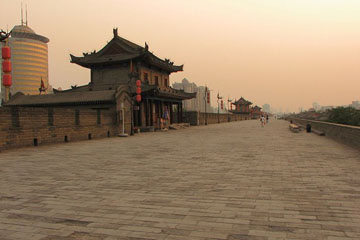
- The Ancient City Wall
Today we will visit Shaanxi History Museum, Xian City Wall, and The Grand Mosque. We will then travel by high-speed train to Luoyang.
Shaanxi History Museum: This provincial museum is one of the major museums in China. It holds numerous unearthed cultural artifacts from within the Shaanxi province as well as the rest of China. It covers 65,000 square meters, with a building area of 60,000 square meters. The newly built modern building recreates Tang-dynasty architecture and successfully symbolizes the great extent of Shaanxi history and its remarkable culture.
The Ancient City Wall: This is the most complete city wall that has survived in China as well being one of the largest ancient military defensive systems in the world. It was enlarged in Ming Dynasty (1368-1644) from the city wall initially built in Tang Dynasty (618 -907). Now it is 12 meters tall, 12-14 meters wide covering 14 kilometers in length with a deep moat surrounding it. The City Wall has corner towers, ramparts, sentry towers, gate towers, battlements and a number of city defensive fortifications with very strong defense capability. You can walk, even cycle on the wall. Its south gate is the largest with a suspension bridge. Most of the tourists choose the south gate for sightseeing.
Grand Mosque (and Old Muslim Quarter): The Grand Mosque is a Chinese traditional Alhambresque architecture with a long history and grand scale, and is a great combination of Islamic and Chinese culture. It was recorded that it was established in the first year of the Tian Bao reign by the Tang Dynasty Emperor Li Lung Ji (685AD-762AD). After renovations and expansions on several occasions in the Song, Yuan and especially the Ming and Qing Dynasties, it gradually took on the current appearance. The whole mosque has more than 12,000 square meters, the floor space more than 4,000 square meters. The construction is mostly in the Ming Dynasty style. The Mosque therefore has much Chinese traditional touch in both its design and artistic outlook. Besides the style peculiar to Islamic mosques, this Mosque also holds characteristics of Chinese pavilions with painted beams and engraved ridgepoles. The Grand Mosque and the Muslim Quarter are now an important cultural preservation of Shanxi Province and a national-level historical/cultural preservation site.
Day 16
Luoyang-

- Pagoda Forest
After breakfast we will head to Shaolin temple and Pagoda forest while enjoy the kungfu show, we can arrange for a vegetarian lunch.
Shaolin Temple & Pagoda Forest: This temple is shrouded in legend and mystery. The origin of martial arts and kungfu is part of the mystique of Shaolin Temple and the Shaolin monks. This is probably the most famous temple in China, not only because of its long history and its role in Chinese Buddhism, but also because of its martial arts or Wushu. Throughout its history it has been reputed to be 'the Number One Temple under Heaven'. Included on UNESCO's World Cultural & Natural Heritage List in 2010, the temple is the cradle of the Chinese Zen Buddhism and the Shaolin Martial Arts such as Shaolin Cudgel. There is a theatre (about 200 seats) here which presents the famous Kungfu Show at 0930, 1030, 1130, 1400, 1500, and1600.
Day 17
Luoyang-

- White Horse Temple
After breakfast we will visit Longmen Grottoes and White Horse Temple. You will have the rest of the day free to explore this ancient city on your own.
The Longmen Grottoes: Located near Luoyang, Henan Province, the Longmen Grottoes are a treasure house of ancient Buddhist cave art. Live cultural relics lie amid green mountains and serpentine rivers. In 2000, it was enlisted into the List of World Heritage. The grottos were hewed and carved during the Northern Wei Dynasty (386-534), when the rulers relocated their capital at Luoyang near the end of the 5th century. At that time Buddhism was spreading east into China and was venerated by the imperial court. The Buddhists adopted the practice of carving rock temples, dedicated to the Buddha.
White Horse Temple: Backed by Mangshan Mountain and facing the Luohe River, White Horse Temple lies about 20 kilometers to the east of Luoyang city, Henan province. It was the first Buddhist temple in China, established under the patronage of Emperor Ming in the Eastern Han capital Luoyang in the year 68. Since White Horse Temple, Buddhism monasteries in China traditionally began to be called 'temple'. White Horse Temple as a result was ever since regarded as the cradle land of Buddhism in China. In history, highly accomplished Buddhist monks from China, even world-renowned Buddhist monks from abroad used to pay visits to White Horse Temple in pursuit of Buddhism inspirations and wisdom; it was thereby also called the 'Home of Sakyamuni' or the 'Court for Ancestors'.
Day 18
LuoyangIn the morning you will leave Luoyang to your next destination. (the airfare and the tax are on your own, but we can help you book the ticket, and the service is free)
| Travel in party of |
Superior Class ★★★★★ |
Deluxe Class ★★★★ |
Tourist Class ★★★ |
| 2-5 persons | N | $ | $ |
| 6-9 persons | N | $ | $ |
| 10 persons & above | N | $ | $ |
| Single room Supplement | N | $ | $ |
Service included:
√ Breakfast in the hotel
√ Personal Guide & Driver + Private car / van for Private Transfers & sightseeing
√ Hotels (twin share bases) as listed in the itinerary .
√ Domestic flights or trains as listed in the itinerary
Train (soft sleeper): Kashgar to Kuqa, Kuqa to Turpan , Turpan to Dunhuang, Dunhuang to Lanzhou, Lanzhou to Xi'an
Xi'an to Luoyang
√ Service Charge & Government Taxes .
√ Luggage Transfers between airports and hotels
√ Government letter for visa support
Service excluded:
* Personal expenses. such as laudentry and tips to the guide and driver
* other activities such as boating, camel riding ect






